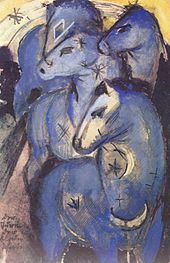False colors
A false or false color representation is a graphic in which colors are used that deviate from the natural color impression . This is where the term false colors or false colors comes from . Scientists use these to make fine nuances of a hue or a gray level in an image clearly distinguishable. In the case of false color representation in the literal sense, the color channels of the original image are assigned to other colors - for example red to blue and blue to green.
In color coding , different color values are assigned to individual brightness levels of a color tone. (See also equidensites )


perception
Humans can perceive natural color stimuli as color valence . This transformation of the physical signal into a psychological perception takes place in the natural (innate) and “experience-influenced” LMS color space . A color stimulus of a certain spectral composition is "seen" almost equally by all normal sighted people from different cultures. Usually, the aim of a pictorial representation is to represent the natural color correctly according to the senses, in that the transformation takes place in a manner that is fair to the sense of sight.
Artists with the oldest "imaging method" have used their artistic freedom . The painter succeeds in deliberately displaying the color valence perceived on the model as a different color stimulus on the canvas by choosing the color means from his individual palette . Examples are Blue Horse I , The Yellow Cow by Franz Marc Blue Horses on Red Grass by Michail Filippowitsch Schatrow and other paintings can easily be found.
Using imaging processes , it is possible to convert the spectral composition of the picture elements on the "input side" into another color space and thus output it as a false color. It happens unintentionally as a color cast when the automatic white balance fails . In the intended applications, slight differences in color can be converted into more clearly visible ones.
The false color display is based on the principle that the human eye's color perception is limited to a few hundred levels of brightness of one color tone, but can differentiate between around a million shades of color. Instead of a gray scale that ranges from white to black, a color scale is used that can range from yellow to red to blue. This creates images that show details much more clearly.
Applications

False color display
Aerial photographs and satellite images are classic areas of application for false color display. These images often do not work with color films that are optimized for the most natural color reproduction possible for the human eye. Instead, individual spectral ranges are mapped onto black and white films or color-insensitive electronic sensors with color filters. Invisible radiation such as ultraviolet or infrared light can also be absorbed in this way. Such multispectral recordings are suitable, for example, to easily distinguish vegetation areas from wasteland or built-up areas, even if they are of a similar color to the human eye. In a false color display, for example, the vegetation can be assigned a shade of red and the wasteland a shade of blue.
Color coding
Many imaging processes in medicine, such as magnetic resonance tomography , ultrasound or X-ray tomography , or in physics, such as thermography , generate images that contain no color information. A color-coded representation is achieved for such images , in that the individual gray levels are represented by different colors in order to clearly identify small nuances in the image. Images to show temperature differences are called heat maps .
For example, different tissue types can be displayed in different colors in an X-ray tomography. The basis for this is a high color resolution of the scanner used.
See also
Individual evidence
- ^ E. Br. Goldstein: Sensation and Perception . Itps Thomson Learning, 2003, ISBN 978-0-534-63991-4

